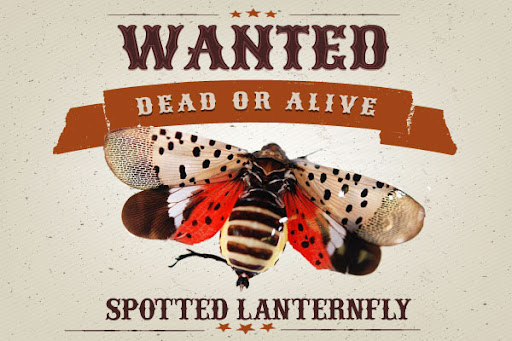Spotted Lanternfly Alert
Spotted Lanternfly Alert
The Spotted Lanternfly is an invasive species
native to Asia. In 2014 it was found in Pennsylvania, and has since spread
to multiple counties which are
now quarantined.
If you see a spotted
lanternfly, it's imperative to immediately report
it online or via phone by calling 1-888-4BADFLY. Especially if you are not inside the
quarantine zone.
What else? Kill it!
Squash it, smash it...just get rid of it. In the fall, these bugs will lay egg
masses with 30-50 eggs each. These are called bad bugs for a reason, don't let
them take over your county next.
In March 2021, the
Pennsylvania Department of Agriculture (PDA) added 8 additional counties (bolded) to the Spotted Lanternfly
Quarantine, for a total of 34 Pennsylvania counties now in quarantine:
|
|
|
A county is placed
under quarantine when evidence of a reproducing population of spotted
lanternflies, such as an egg mass, is found by the Pennsylvania Department of
Agriculture.
Why?
The spotted lanternfly
causes serious damage including oozing sap, wilting, leaf curling and dieback
in trees, vines, crops and many other types of plants. In addition to
plant damage, when spotted lanternflies feed, they excrete a sugary substance,
called honeydew, that encourages the growth of black sooty mold. This mold is
harmless to people however it causes damage to plants. In counties
infested and quarantined for spotted lanternfly, residents report hundreds of
these bad bugs that affect their quality of life and ability to enjoy the
outdoors during the spring and summer months. Spotted lanternflies will cover
trees, swarm in the air, and their honeydew can coat decks and play equipment.
In addition to
damaging trees and affecting quality of life, the spotted lanternfly is a
huge threat to Pennsylvania agriculture industry. The economic impact could
total in the hundreds of millions of dollars and hundreds of thousands of jobs
for those in the grapes, apple, hops, and hardwood industries.
Identification
The spotted lanternflyOpens In A New
Window adult is approximately 1" long and 1/2" wide
at rest. The forewing is grey with black spots and the wings tips are
reticulated black blocks outlined in grey. The hind wings have contrasting
patches of red and black with a white band. The legs and head are black; the
abdomen is yellow with broad black bands. Immature stages are black with white
spots, and develop red patches as they grow.
What
happens after you report spotted lanternfly?
Both the PDA and the
U.S. Department of Agriculture (USDA) value all public reports for spotted
lanternfly, but they are not able to respond to every report as they receive,
on average, more than 1,500 reports a week.
PDA and USDA follow up
with all reports of Spotted Lanternfly in Pennsylvania counties that are not
quarantined for spotted lanternfly to discover, contain and limit further
spread of the invasive insect.
They also use all the
reported data from across the Commonwealth to better understand the spread and
numbers of the invasive insect, which directly contributes to when and where
they treat.




Yorumlar
Yorum Gönder